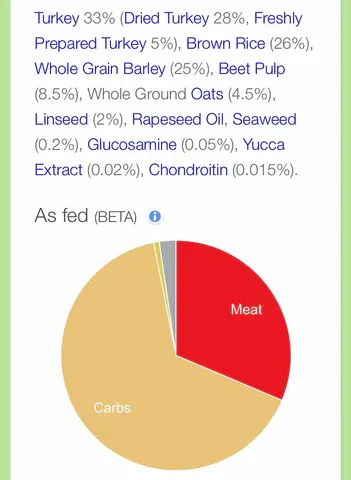Choosing the right dry dog food can make all the difference in your pet’s health and vitality. As a Pets at Home own-brand product, Wainwright’s is often pushed by staff, but we’re diving deep into its nutritional value. Today, we’re reviewing five key recipes to see if this kibble lives up to the hype for puppies, adults, and seniors. If you’re wondering about best dry dog foods, let’s break down the ingredients honestly.
Wainwright’s has a reputation for recipe changes that frustrate loyal customers, often tied to supply chain shifts. While mass-produced kibble must adapt, this can compromise quality. Dogs thrive on high-meat, low-carb diets—carbs mainly bind the kibble, not fuel your pup. Low-glycemic carbs are ideal if any are included, prioritizing digestible proteins for energy and coat health.
 Wainwright's puppy food ingredient label showing grains like brown rice and barley
Wainwright's puppy food ingredient label showing grains like brown rice and barley
Puppy Dry Food: Too Grain-Heavy for Growing Pups
Wainwright’s dry puppy formula starts promising but quickly falters with high levels of brown rice, maize, barley, and oats. Puppies need nutrient-dense meat as the star—grains like these spike blood sugar and offer little beyond filler. According to veterinary nutritionists from the American Kennel Club, young dogs require 22-32% protein from animal sources for muscle and bone development, not carb overload.
This recipe prioritizes carbs over premium meats, which isn’t ideal for sensitive tummies or active breeds. For better options, consider kibbles with named meat meals as the top ingredient.
Adult Light Recipe: Carbs Dominate Seniors’ Needs
The adult light variant is particularly concerning, packing 26% brown rice and 25% barley. Senior dogs demand highly digestible proteins to support aging joints and organs, not bulky grains that expand during digestion. Vets often warn that excessive carbs can lead to weight gain and diabetes risk in older pets.
 Wainwright's adult light dog food label highlighting high barley and rice content
Wainwright's adult light dog food label highlighting high barley and rice content
Barley and rice act as cheap fillers, diluting the meat content. If you’re feeding what human food can you feed dogs, opt for safe proteins over these processed carbs.
Mature Recipe: Rice as the First Ingredient?
Even worse is the mature formula, leading with 35% brown rice, followed by 30% turkey meat meal and gravy, then 18% barley. Rice swells when hydrated, bulking up stools but providing minimal nutrition. The World Small Animal Veterinary Association emphasizes meat-based proteins for seniors to maintain lean muscle mass.
This setup prioritizes cost over canine biology—dogs are carnivores at heart, not grain grazers.
 Wainwright's mature dog food label with brown rice listed first
Wainwright's mature dog food label with brown rice listed first
Premium Lines: Free Run Chicken, Duck, and Turkey Rice
Wainwright’s “free run” premium range—like chicken with superfoods, free run duck, and turkey with rice—starts strong with quality meats upfront. However, carbs creep in via white potato, potato protein, and vegetable stock instead of animal-based alternatives.
These starchy veggies inflate the glycemic load, and at a premium price, the filler ratio disappoints. Superfoods add antioxidants, but they can’t offset the carb-heavy base. Curious about meats? Check what meat to not feed dogs to avoid similar pitfalls in homemade diets.
 Wainwright's free run premium dog food label showing potato and vegetable ingredients
Wainwright's free run premium dog food label showing potato and vegetable ingredients
Staff at Pets at Home favor Wainwright’s and AVA for sales, not superiority. Explore what can dogs eat for dinner for balanced meal ideas beyond kibble.
Final Verdict: Better Choices Exist
Wainwright’s dry dog foods fall short with excessive grains across puppy, adult, light, mature, and premium recipes. While affordable, they stray from high-meat ideals backed by canine nutrition experts. For optimal health, seek brands with 40%+ meat content and minimal fillers—consult your vet for personalized picks.
Prioritize your dog’s longevity over convenience. Read more on safe feeding like what is the one meat that dogs should never eat and what human meat is bad for dogs.
References
- American Kennel Club: Puppy Nutrition Guidelines
- World Small Animal Veterinary Association: Senior Dog Feeding Recommendations
